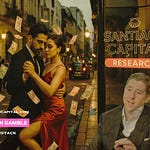“In the land of the blind, the one-eyed man is king.” – Desiderius Erasmus
The financial world has no shortage of grand theories.
Most are quickly discarded, replaced by newer, shinier models that promise to explain market movements with the clarity of a crystal ball.
And yet, every so often, a theory comes along that refuses to be ignored—one that keeps proving itself right, much to the chagrin of those who had bet against it.
Enter the Dollar Milkshake Theory.
For years, Brent Johnson has been arguing that, contrary to mainstream expectations, the U.S. dollar would strengthen, not weaken, as global liquidity tightened.
The Milkshake, as it’s affectionately called, describes a dynamic where capital flows from weaker economies into the U.S. dollar, creating a feedback loop that amplifies dollar strength at the expense of virtually everything else.
Some have dismissed it. Others have ridiculed it. But reality has an amusing way of making fools out of naysayers.
With markets now struggling under the weight of a rising dollar, surging U.S. equity prices, and a financial system that increasingly resembles a game of musical chairs, it’s worth revisiting the theory that saw it coming.
The Anatomy of the Milkshake
At its core, the Dollar Milkshake Theory is elegantly simple.
Imagine the global monetary system as a giant milkshake, with various currencies and assets mixed together in a complex swirl of liquidity.
The U.S. dollar, the world’s reserve currency, is the straw stuck in the shake.
As capital flees instability, uncertainty, and poor investment conditions elsewhere, it gets sucked up through the dollar straw, concentrating liquidity into U.S. assets while draining it from the rest of the world.
The implications are profound.
A rising dollar makes it more expensive for foreign borrowers—who collectively hold trillions in dollar-denominated debt—to service their obligations.
It also tightens global financial conditions, as international trade and commodity pricing become more costly.
Meanwhile, U.S. investors benefit from capital inflows that buoy equities, real estate, and other assets, at least in the short term.
Critically, this isn’t just a theory—it’s happening in real time.
Over the past five years, the U.S. Dollar Index (DXY) has strengthened considerably, defying predictions of its demise.
Bonds have struggled, interest rates have climbed, and global markets have endured wave after wave of financial stress.
The Milkshake, it would seem, is very much in effect.
Winners, Losers, and the Endgame
Not everyone experiences the Milkshake in the same way.
The U.S., despite its own economic challenges, finds itself in a relative position of strength. With capital pouring in, asset prices have remained resilient, and the dollar has continued to defy expectations.
For emerging markets, however, the story is less rosy.
Countries with high levels of dollar-denominated debt are particularly vulnerable, as rising interest rates and a stronger greenback make repayment increasingly difficult.
Nations like Argentina, Turkey, and South Africa have already felt the sting, and more could follow if dollar appreciation continues.
Even developed economies are not immune.
The Bank of England was forced to intervene in its bond market in 2022, while the European Central Bank scrambled to contain a debt crisis in Italy.
Japan, meanwhile, has spent billions propping up the yen as the carry trade unwinds.
These are not isolated incidents—they are symptoms of a financial system under strain from the very forces the Milkshake describes.
The Most Important Chart You’re Not Watching
Critics of the Milkshake Theory often argue that it’s impossible to measure. But Johnson has a simple response: Just look at the charts.
Gold, equities, interest rates, and bonds have all moved in line with the Milkshake’s predictions.
As the dollar has strengthened, U.S. stocks have outperformed, while foreign markets have lagged.
The bond market has been decimated, and interest rates have risen sharply. If the theory were wrong, these moves would have played out differently.
Take the U.S. 10-year Treasury yield, which has climbed from 1.5% to over 4% in just a few years. Or the S&P 500, which has remained resilient despite global economic headwinds.
These are not coincidences—they are the direct result of capital seeking refuge in U.S. assets.
What’s Next?
So where does this all lead?
If the Milkshake continues to play out, we can expect more volatility, more capital flows into U.S. assets, and increasing pressure on global markets.
Some argue that the endgame is a crisis—one where dollar strength ultimately forces a financial reset of some kind.
Others believe the system can muddle through, with periodic crises giving way to new interventions and policies aimed at maintaining stability.
Either way, the message for investors is clear: Ignore the Milkshake at your peril. Understanding its mechanics isn’t just an academic exercise—it’s a necessary tool for navigating the turbulent waters ahead.
How to Position Yourself
For those looking to hedge against the uncertainties of a Milkshake-driven world, a few key strategies stand out:
Hold Dollars – As the cleanest dirty shirt in the laundry pile, the U.S. dollar remains a safe haven in times of market stress. While long-term debasement is a concern, holding cash during liquidity crises can be a lifesaver.
Own Gold – While gold may struggle in the short term due to a rising dollar, history has shown that it ultimately benefits from periods of financial stress. A diversified allocation can provide a hedge against systemic risks.
Stay in Quality U.S. Equities – As long as capital continues flowing into the U.S., domestic stocks should remain resilient. Focus on high-quality companies with strong balance sheets and durable competitive advantages.
Limit Emerging Market Exposure – Countries with high levels of dollar debt are at risk. Be selective about international investments, and consider hedging currency exposure.
Watch for Policy Shifts – Central banks and governments are not passive actors. Be prepared for interventions, bailouts, and other policy moves aimed at managing the fallout from a stronger dollar.
Final Thoughts
The Dollar Milkshake is not just a theory—it’s a lens through which to view the unfolding financial landscape. While no framework is perfect, few have been as prescient in explaining the current state of global markets.
For those who dismissed it, the past few years have been a humbling experience. For those paying attention, it has been an invaluable guide. And for those still on the fence—well, the Milkshake isn’t done yet. Best grab a straw.
🔴 Industry Pro? Consider upgrading to our professional research service…
Everything in this service is for educational and entertainment purposes only and NOT investment advice. If you act on anything provided in this offering, you are doing so based on your own research. Nothing in this service is an offer to sell or to buy any security. The author is not responsible for any financial loss you may incur by acting on any information provided in this service. Before making any investment decisions, talk to a financial advisor.












